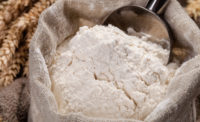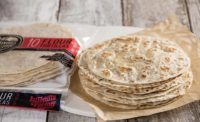By Lena Bosc-Bierne, Product & Applications Specialist, KPM Analytics
Tortillas represent a large and growing sector of baked goods. They are a popular low-carbohydrate bread replacement among consumers and are available in many types on the global market. The numbers do not lie: the tortilla market is expected to increase at a high CAGR of 5.45% in the global market to account for the more significant market value of approximately $55.5 billion in a forecast period from 2022-to-2030 (Market Research Future [MRFR] 2022).
Consumer tastes are a significant driver of this demand, and not just any tortilla will do. Clean label, vegan, organic, and non-GMO verified tortillas are important in their buying decision. As a result, high-quality raw ingredients are essential for tortilla production, especially if improvers or additives are not an option for the product.
Corn tortillas are traditionally a popular choice—both as a gluten-free alternative and its health benefits—but flour tortillas represent the fastest-growing segment during this forecast period.
Flour tortilla appearances are key in consumers' purchasing choices
While there are different methods to produce flour tortillas—hot-press, hand-stretch, and die-cut, as examples—they are a generally simple product compared to other baked goods. They begin with a dough of flour, water, and salt, along with fat and leavening agents. Then, they are formed into balls of dough, flattened, and baked to their ideal consistency.
Good-quality tortillas are symmetrical, uniform, opaque, toast-marked, puffed, soft, flexible without cracking, and have a long shelf life. Because product appearance is an essential factor in tortilla production, many companies have invested in automated methods to assess tortillas before packaging (fig.1). These companies have developed entire product databases based on consumers' visual expectations. Examples include consistent tortilla size, color, toast marks, anomalies (holes, folds, tears), jagged edges, and other visible traits. Textural aspects are also a top priority; tortillas that appear dry and crumbly or do not roll or fold without resistance may indicate poor shelf life that reflects negatively on a brand.
From a flour tortilla manufacturer’s perspective, if any product appearance changes happen during a production run, their first thought may be to blame their production process. Most producers are less focused on why or how these variations occurred and instead take a reactive approach to fix issues on a case-by-case basis.
However, poor ingredient quality can ruin all efforts, even with complete control over the production process. Because the recipe is relatively uncomplicated, the quality of the finished product depends significantly on the quality of the ingredients.
Relying solely on static flour specifications from millers is risky
Many bakers prioritize flour parameters like protein, starch, and ash content, which they specify to their miller. Unfortunately, most tortilla manufacturers today merely accept flour deliveries from their millers without doing their due diligence to ensure the miller’s specifications meet exact standards. Millers only typically state protein quantity on their deliveries, but do not provide information on the quality of protein, or the availability of starch.
Many flour tortillas manufacturers may not realize that product inconsistencies result from an imbalance of specific and controllable flour parameters. Rather than guessing at the cause of the issue, or worse, simply making on-the-fly manual adjustments to a recipe until it looks correct, with just a little education, flour tortilla producers can become more proactive and reduce product inconsistencies before they start.
What is causing these common flour tortilla production challenges?
1) Dough Stickiness
Suppose the flour tortilla dough in the mixer appears excessively sticky. Typically, the tortilla maker will simply add more flour or reduce water to their mixer until they arrive at a reasonable consistency for their dough. This subjective and potentially costly practice can lead to processing machine problems when dividing and pressing tortillas.
Even if all other measurements are correct, an imbalance of starch damage or low levels of protein can cause an excessively sticky dough. On the contrary, an excess of pentosans and protein content in the flour can create a dough that is too loose.
2) Tortilla Size and Shape Inconsistencies
Gluten quality directly impacts a tortilla’s size and shape, as it relates to the elasticity and extensibility of tortilla doughs and their ability to hold their shape for baking.
Also, a too-small tortilla often has flour made with harder wheat. On the other hand, a weak flour can give a thinner tortilla with less gas retention.
3) Tortilla Rollability/Foldability/Flexibility
Flexibility is a crucial parameter of tortilla quality, and protein has a direct effect. Low protein content (<9%) will yield an inflexible, brittle, but more extensible product. On the other hand, higher protein (>12%) will give a more flexible tortilla but one of a smaller diameter.
Beyond protein quantity, the quality of the protein network and the extensibility/elasticity balance it possesses and supplies the dough is critical. Flexibility is also positively influenced by the addition of amylase and lower levels of starch damage.
4) Shelf Life
After baking, starch in the tortilla tends to recrystallize partially. This phenomenon is called starch retrogradation, which has detrimental effect on the sensory and storage qualities of many starchy foods like tortillas. The faster the retrogradation, the quicker the flour tortilla will lose its freshness. Again, starch damage and other flour quality factors can affect the speed of retrogradation.
How to control flour quality factors
Starch damage control
To measure starch damage—a natural byproduct of the milling process—automated functional analysis instruments (fig. 2) offer a quick way to confirm starch damage availability. The manufacturer can then adjust their recipe or communicate this to their miller to correct the issue.
Protein/Pentosans control
Then for protein and pentosans control, near-infrared (NIR) technologies offer a simple method to confirm their availability. For instance, a benchtop analyzer (fig. 3) can provide comprehensive measurements of protein quantity and pentosans, ash content, moisture, and more. These instruments offer the benefits of a quality lab in a single benchtop instrument.
Extensibility/Elasticity control
Alveograph instruments (fig. 4) help manage parameters like protein quality that influence flour tortilla flexibility and its ability to maintain shape. These technologies measure the extension of a dough bubble formed by air pressure. This process reproduces the deformation of the dough when subject to carbon dioxide during fermentation. The latest alveographs like the CHOPIN Technologies Alveolab now offer the ability to analyze whole wheat flours, another growing tortilla category.
Measuring starch damage availability in flour is a good start to control starch retrogradation. Some analytical instruments are able to subject a dough sample through the entire baking process and measure starch retrogradation by monitoring the dough's consistency as the sample cools down.
Also, corn tortilla manufacturers can use this same principle to measure masa quality.
Remove the guessing game from the flour tortilla manufacturing process
With demand for flour tortillas on the rise, now is the time for tortilla manufacturers to take stronger command of their manufacturing process to elevate their brand in a crowded marketplace. Managers can start on a new path to improve product consistency by prioritizing flour quality analysis to troubleshoot potential problems before they become costly production issues.








